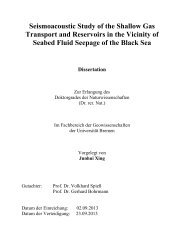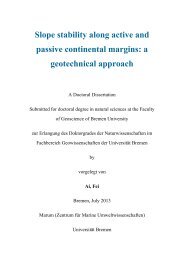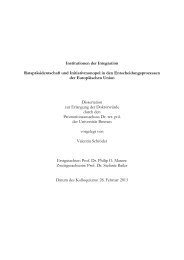aus dem MARUM und dem Fachbereich Geowissenschaften der ...
aus dem MARUM und dem Fachbereich Geowissenschaften der ...
aus dem MARUM und dem Fachbereich Geowissenschaften der ...
Create successful ePaper yourself
Turn your PDF publications into a flip-book with our unique Google optimized e-Paper software.
MARIA S. MERIAN-Berichte, Cruise 20, Leg 4, Bridgetown – Freeport, 15.3.2012 – 7.4.2012<br />
where "real" CWC mo<strong>und</strong>s show a clear current-controlled growth pattern. However, ROV dives<br />
carried out during MSM 20-4 (Fig. 6.25) showed that also in this area the mo<strong>und</strong>-like seabed<br />
structures largely originate from slump-related rocks. Though, coring results reveal that these<br />
rocks are at least covered by 1-2 m of coral-bearing sediments.<br />
northern mo<strong>und</strong><br />
Twin Peaks mo<strong>und</strong><br />
Mount Gay<br />
small mo<strong>und</strong><br />
Fig. 6.25 Overview of the Great Bahama Bank working area showing all sampling sites (GeoB station numbers<br />
are indicated) and ROV dive tracks conducted during cruise MSM20-4. The map displays mo<strong>und</strong><br />
structures in a field of slightly divergent ridges and depressions that are reminiscent of a flow pattern. To<br />
the west a scar of 50 m in height separates this area from a soft sediment slope (in ochre) with regularly<br />
spaced furrows. The yellow line gives the position of the PARASOUND profile shown in Fig. 6.27.<br />
Therefore, it is assumed that the mo<strong>und</strong> structures fo<strong>und</strong> along the Great Bahama Bank most<br />
likely result from slump deposits exhibiting a rocky core that defines the overall morphology and<br />
explains the lack of correlation between mo<strong>und</strong> orientation/size and bottom current regime (see<br />
above). Interestingly, also the inter-mo<strong>und</strong> areas, although having a largely smooth appearance<br />
in the MBES data, are often covered by metre-sized boul<strong>der</strong>s. Strong bottom currents are<br />
indicated by e.g. gravel pavements and current ripples. Hemipelagic mud was only fo<strong>und</strong> in<br />
sediment samples collected from the mo<strong>und</strong> structures where those fine-grained sediments have<br />
been deposited in between the fossil coral framework. The ROV observations revealed that the<br />
occurrence of living CWC (i.e. CWC ecosystems) is today limited to a water depth of

















